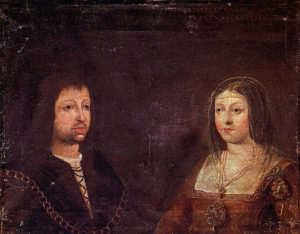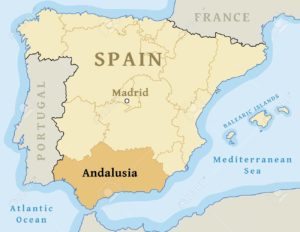“Flamenco” is a genre of Spanish song and dance that originated in the southern Spanish region of Andalucía. It is an utterly remarkable, physically and expressively thrilling hybrid/synthesis/melding of native Spanish, North African, Arab, and especially gypsy influences.
In my humble (but well-informed) opinion, Flamenco is – along with jazz – the most viscerally exciting music to be found on this planet. I would go so far as to suggest that if Andalucía were a media giant equal to the U.S. of A., we’d all be singing and dancing to Flamenco and not that north American-born hybrid called rock ‘n’ roll.
(For our information: on November 16, 2010, UNESCO – the United Nations Educational, Scientific and Cultural Organization – declared Flamenco to be one of the “Masterpieces of the Oral and Intangible Heritage of Humanity.”)
Damn straight.
For reasons geographic and cultural, Flamenco could only have evolved in Spain.
A Country Apart
With the Pyrenees (topping out at 11,168 feet high) to the north, the Atlantic Ocean to the West and the Mediterranean Sea to the south and east, Spain (and its Iberian sibling Portugal) stands physically apart from the remainder of Western Europe.
In terms of the abundance, variety, and preservation of its folk music, Spain again stands apart from the rest of Western Europe. To a unique degree, old traditions and festivals have been preserved in Spain, and with them, the music that evolved long ago to accompany those traditions and festivals.
In terms of it’s ethnic and cultural DNA, Spain can boast a degree of diversity well beyond that of any of its Western European neighbors. That’s because Spain has been invaded, pillaged and occupied by more races and nationalities more often than the discount table at your local Wal-Mart. Greeks, Phoenicians, Carthaginians, Celts, Romans, North African Berbers, Visigoths, Arabs – among others – have all trundled through at one time or another and left something of their cultures and genomes behind, there to intermix and congeal into cultures quite new. Jews, gypsies, equatorial Africans, Byzantines, French troubadours, Italian and English traders, and Native Americans brought back from the colonies in the New World passed through as well, leaving something of their lives, genes, and cultural essence behind.
Nowhere is this cultural smörgåsbord more pronounced, and its results more musically dramatic, than in Andalucía, the southernmost and most populous region in Spain.
A Little History
In the year 19 B.C.E., the Romans completed their conquest of the Iberian Peninsula, a region they called Hispania. Hispania quickly became one of the wealthiest of all Roman provinces: the breadbasket for much of the Empire and a rich source of minerals and metals as well. It was also rich in human capital: Hispanic soldiers were known for their toughness and enterprise, and three Roman soldiers of Hispanic origin went on to become three of Rome’s greatest Emperors: Trajan, Hadrian, and Marcus Aurelius.
Rome was not built in a day, and neither did it crumble in one, but by the fifth century, Hispania had been invaded and occupied by a succession of central European – that is, Germanic – tribes: the Suebi, the Visigoths, and the Vandals among them. But no single foreign invasion was to have a more lasting impact on Spain than the one that occurred between 711 and 718, when Muslim armies conquered nearly all of the Iberian Peninsula. These Muslim conquerors were collectively referred to by Europeans as the “Moors”. They consisted of Berbers (north Africans), Black Africans, and Arabs. The Moorish invaders called their new European territory Al-Andalus.
Over time, Christian armies chipped away at Al-Andalus. In 1085, King Alfonso VI of Leon and Castile captured the great cultural city of Toledo, 42 miles south of Madrid. In 1249, the “Reconquista” – the “reconquering” – of what today is Portugal was complete. Eventually, all that was left of Moorish Spain was the “Emirate of Grenada” in the south.

1492 was a good year for the Spanish King and Queen Ferdinand and Isabella. Not only did they finance that Genoese crackpot Christopher Columbus to sail west on the ocean blue, but they also oversaw the final Reconquista of Spain. On January 2 of 1492, after a grinding ten-year war, the Moorish Sultan Muhammad XII surrendered the fortress palace of Grenada – the famed Alhambra itself – directly to Ferdinand and Isabella. With that, nearly 800 years of Muslim rule in Spain came to an end. The last Moorish region of Spain, the Emirate of Grenada, retained its Moorish name, and is known as Al-Andalus – as Andalucía – to this day.

Muslim rule in Spain might have been over, but its cultural impact was not. And nowhere was that more true than in Andalucía, with its incredible melding of Christian and Muslim, European and African cultures. Many of the cultural elements that we, today, consider as being quintessentially Spanish – like Flamenco, bullfighting, and Moorish-styled architecture – all originated in Andalucía.
Of all the very many folk music traditions that evolved and have been preserved in Spain, none has had a greater impact on Spanish culture and the international community than Andalucían Flamenco.
Flamenco consists of four elements: cante (meaning singing), toque (which is the especially percussive style of guitar playing typical of flamenco), dancing, and palmas (percussive handclapping).

The word “flamenco” is Spanish for “flamingo”: a tall, slim, elegant bird with pinkish-white plumage, native to southern Spain. While the exact connection between the “bird” and the artistic tradition is unknown, there can be no doubt that flamenco dancing – with its angular, stylized movements and red costuming – does indeed resemble the movements, coloring, and plumage of the flamingo.
We would isolate four stereotypical elements of flamenco: rhythm; mode (meaning the sorts of scales employed in the music); the guitar; and dance. … continue reading and see Dr. Bob’s prescribed recordings (and DVD) only on Patreon!
